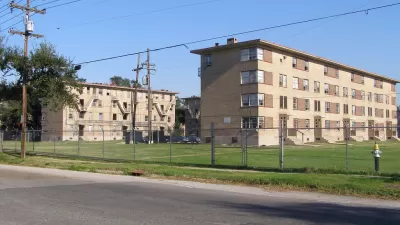The amendment is a thorn in the side of affordable housing advocates, who blame "Faircloth Limits" for inhibiting public housing construction.

As the debate over federal housing policy heats up, Jared Brey provides a concise explanation of the Faircloth Amendment, a 1990s-era rule that has been a recent target of affordable housing advocates. Touted as the "first step to addressing the country’s housing affordability problem" by Ross Barkan in the New York Times, repealing the amendment would "remove a legal obstacle to a series of ambitious housing plans that progressives have rallied behind."
Introduced as part of the 1998 Quality Housing and Work Responsibility Act, the Faircloth Amendment amended the Housing Act of 1937 to maintain public housing units at 1999 levels, effectively preventing housing authorities from ever maintaining more public housing than they did then. The amendment was enacted amid a broader welfare reform movement "grounded in a belief that public assistance programs were detrimental to people’s ability to achieve economic independence." In the 1990s, many lawmakers had a perception of public housing as "crime-infested, unhealthy places that kept people trapped in poverty."
However, "Faircloth Limits" aren't the biggest factor in limiting affordable housing. "Since the 1980s, the restriction of federal funding has had a much bigger impact on public housing than the Faircloth Amendment," and many cities own fewer units than their Faircloth limits allow. A lack of federal funding is the most pressing obstacle facing affordable housing production, but with proposals like the Green New Deal for Public Housing on the table, which calls for $180 billion in spending, significant change in federal housing policy seems more possible.
FULL STORY: What Is the Faircloth Amendment?

Alabama: Trump Terminates Settlements for Black Communities Harmed By Raw Sewage
Trump deemed the landmark civil rights agreement “illegal DEI and environmental justice policy.”

Planetizen Federal Action Tracker
A weekly monitor of how Trump’s orders and actions are impacting planners and planning in America.

The 120 Year Old Tiny Home Villages That Sheltered San Francisco’s Earthquake Refugees
More than a century ago, San Francisco mobilized to house thousands of residents displaced by the 1906 earthquake. Could their strategy offer a model for the present?

Ken Jennings Launches Transit Web Series
The Jeopardy champ wants you to ride public transit.

BLM To Rescind Public Lands Rule
The change will downgrade conservation, once again putting federal land at risk for mining and other extractive uses.

Indy Neighborhood Group Builds Temporary Multi-Use Path
Community members, aided in part by funding from the city, repurposed a vehicle lane to create a protected bike and pedestrian path for the summer season.
Urban Design for Planners 1: Software Tools
This six-course series explores essential urban design concepts using open source software and equips planners with the tools they need to participate fully in the urban design process.
Planning for Universal Design
Learn the tools for implementing Universal Design in planning regulations.
Clanton & Associates, Inc.
Jessamine County Fiscal Court
Institute for Housing and Urban Development Studies (IHS)
City of Grandview
Harvard GSD Executive Education
Toledo-Lucas County Plan Commissions
Salt Lake City
NYU Wagner Graduate School of Public Service





























